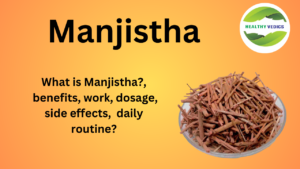Manjistha

Manjistha (Rubia cordifolia), also known as Indian Madder, is a valuable herb in Ayurvedic medicine, particularly recognized for its blood-purifying properties. Here’s a breakdown of your questions:
What are Manjistha?
- Manjistha is a perennial climbing plant whose roots are used in traditional medicine. It’s known for its reddish-brown roots and its use as a natural dye.
How many calories are there in Manjistha?
- When used in typical medicinal amounts, Manjistha contributes a negligible amount of calories. Therefore, it is not common to find caloric values for Manjistha.
What substances are there in Manjistha?
- Manjistha contains various bioactive compounds, including:
- Anthraquinones (like rubiadin and alizarin)
- Glycosides
- Triterpenoids
- Flavonoids
What are the benefits of eating Manjistha?
- Potential benefits include:
- Blood purification and detoxification.
- Improving skin health (treating acne, eczema, and other skin conditions).
- Anti-inflammatory effects.
- Supporting liver and kidney function.
- Supporting lymphatic system health.
What are the disadvantages of Manjistha?
- Potential disadvantages and side effects:
- May cause changes in urine color (reddish).
- Can cause mild digestive upset in some individuals.
- Potential interactions with certain medications.
- Should be used with caution during pregnancy and breastfeeding.
When should Manjistha be eaten?
- Manjistha is often taken on an empty stomach or as directed by an Ayurvedic practitioner. It can also be taken with warm water or milk.
How should Manjistha be eaten?
- Manjistha is available in various forms:
- Powder: Mixed with water, milk, or honey.
- Capsules/tablets.
- Decoctions (herbal teas).
- Topical application in pastes or oils.
Which disease is cured by eating Manjistha?
- Manjistha is not a “cure” for diseases, but it’s used to support the body’s natural healing processes. It has been used traditionally to support conditions such as:
- Skin disorders.
- Inflammatory conditions.
- Detoxification of the blood.
How many Manjistha should be eaten in a day?
- Dosage varies depending on the form of Manjistha and individual needs. It’s crucial to consult with a healthcare professional or an Ayurvedic practitioner for personalized recommendations.
It’s important to remember that herbal remedies can interact with medications and may not be suitable for everyone. Always seek professional medical advice before starting any new herbal treatment.
For more information Visit us :
Website: https://www.healthyvedics.com/
Website Blog: https://www.healthyvedics.com/blog/
Subscriber: https://www.youtube.com/@healthsrainbow4897
Facebook Page: https://www.facebook.com/profile.php?id=100072760131036
Facebook Main Page: https://www.facebook.com/profile.php?id=61551851110556
Instagram: https://www.instagram.com/healthyvedics/
Twitter: https://twitter.com/HVedics
RELATED VIDEO :
- benefits of turmeric : https://youtu.be/ghuW333IV_k
- benefits of eating licorice : https://youtu.be/GClU0qSkOSQ
- Benefits of eating cumin : https://youtu.be/7YTOgdx24Mg
RELATED ARTICLE :
- benefits of liquorice : https://www.healthyvedics.com/blog/2021/10/14/
- benefits of Yohimbine : https://www.healthyvedics.com/blog/2021/10/14/
- benefits of Ashwagandha : https://www.healthyvedics.com/blog/2021/10/09/
VISIT OUR WEBSITE :
This video Covers the information about:
What are Manjistha? How many calories are there in Manjistha? What substances are there in Manjistha? What are the benefits of eating Manjistha? What are the disadvantages of Manjistha? When should Manjistha be eaten? How should Manjistha be eaten? Which disease is cured by eating Manjistha? How many Manjistha should be eaten in a day?
PUBLISHED BY HEALTHS RAINBOW